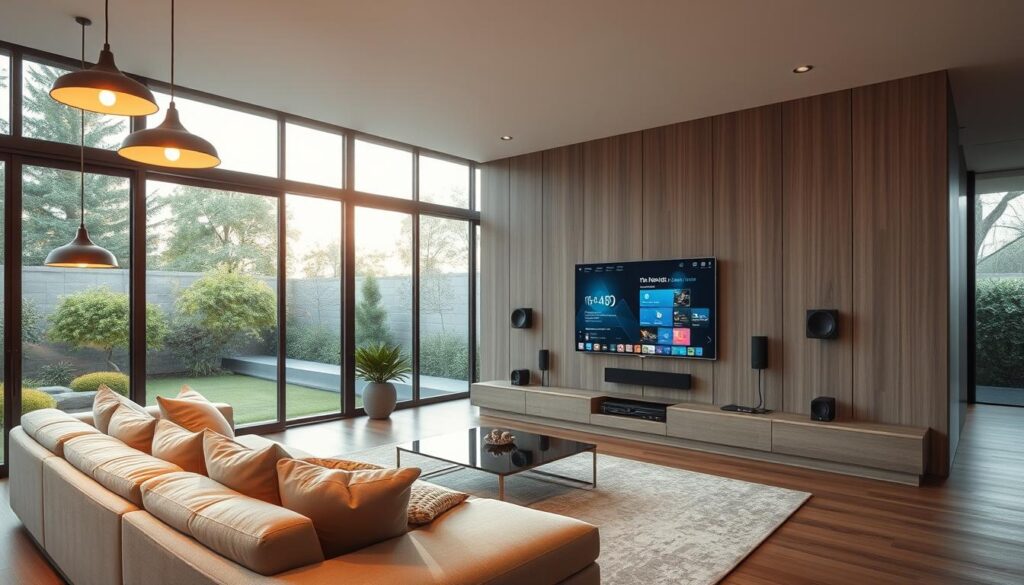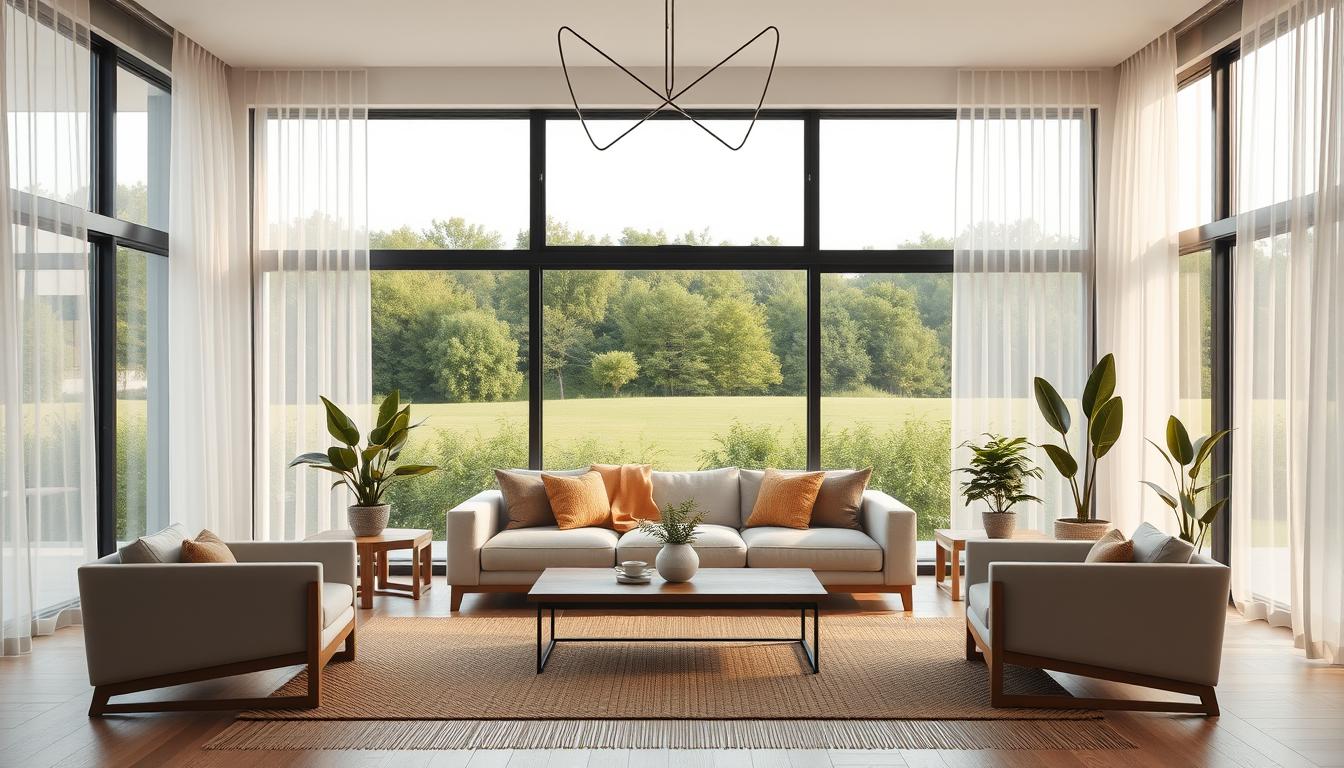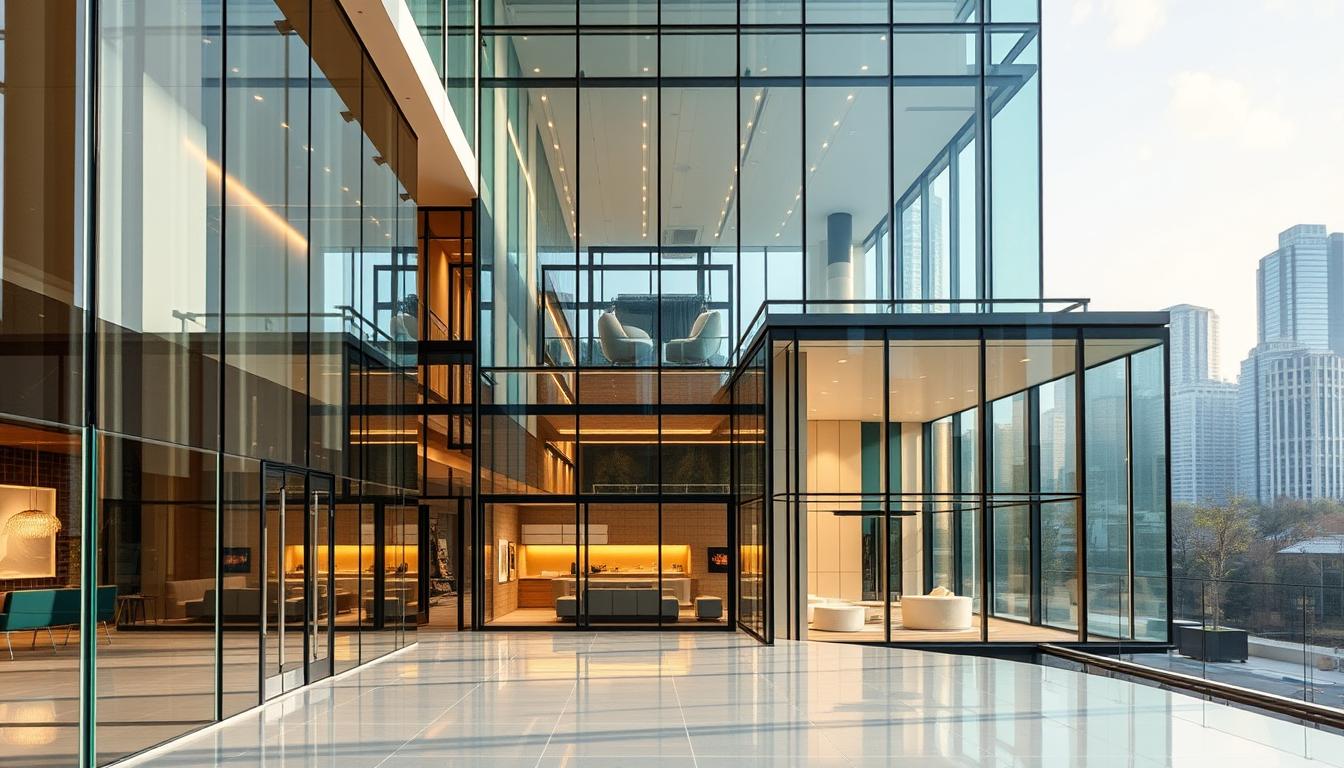Did you know a well-designed contemporary interior can boost a home’s value by up to 10%? This fact shows how crucial it is to have a stylish and useful living area. In our guide, we’ll explore the newest trends and ideas to turn your home into a stunning retreat.
We’ll dive into the basics of modern homes interior design. You’ll learn about picking the right colors and adding unique pieces that show off your style. Our aim is to give you the tools and ideas to make a space that looks great and works well.
Key Takeaways
- Understand the principles of contemporary design
- Learn how to choose a color palette that enhances your space
- Discover the latest trends in modern homes interior design
- Find out how to incorporate statement pieces into your decor
- Create a functional and stylish living space
Understanding the Essence of Modern Home Design
To grasp modern home design, we need to look at its key traits, famous designers, and current trends. It’s more than just looks; it’s about making homes that are both useful and comfy. These homes should show off today’s way of living.
Characteristics of Modern Home Interiors
Modern home interiors are all about sleek home decor. They have clean lines, little decoration, and focus on being useful. A top interior designer says, “Modern design is simple and elegant. It makes a space feel open and tidy.”
They use simple colors, few patterns, and lots of empty space. This makes a home feel calm and peaceful.
The design also makes sure furniture and decor are not just pretty. They must also be useful. This makes the home feel more relaxed and serene.
Influential Designers in Modern Design
Many designers have shaped modern home design. Charles and Ray Eames and Le Corbusier are key figures. Their work has inspired many designers and is still loved today.
Their designs often include luxury interiors with top-notch materials and detail. They aim to make spaces that are not just pretty but also useful and cozy.
Trends in Modern Home Interiors
Today, modern home interiors are using eco-friendly materials, smart tech, and bold colors. There’s a big push for sustainable building materials and designs that save energy.
As we go on, modern home design will keep changing. It will add new tech and ideas. The goal is to mix beauty and usefulness, making homes that are both stunning and practical.
Color Schemes for Modern Interiors
Color schemes are key in modern home design. They set the mood of a room, making it feel spacious and inviting. This is crucial for stylish living spaces.
Choosing colors is more than just picking what looks good. It’s about creating a space that shows your style and fits with minimalist home design. Modern homes often prefer simple elegance, so picking the right colors is important.
Neutral Tones and Their Impact
Neutral colors like whites, grays, and beiges are common in modern design. They create a clean background for furniture and decor. These colors also make rooms look bigger and more open, adding to the modern feel.
Neutral colors are also great because they’re easy to change. You can update your decor without repainting. This is perfect for stylish living spaces where tastes can change.
Incorporating Bold Colors
Bold colors add personality to modern interiors. They can be used on accent walls, furniture, or accessories. This creates a striking contrast with the neutral background.
It’s important to balance bold colors to avoid overwhelming the space. The 60-30-10 rule is helpful: 60% neutral, 30% secondary, and 10% accent. This keeps the space looking minimalist while adding personality.
The Role of Monochromatic Palettes
Monochromatic color schemes use different shades of one color. They create a cohesive look, making them popular for stylish living spaces. These palettes also help with continuity in open-plan homes.
To pull off a monochromatic scheme, mix shades and textures. For example, use light blue walls, navy blue furniture, and sky blue accents. Add different textures like matte and glossy to add depth and interest.
Furniture Selection for Modern Homes
Choosing furniture for modern homes needs careful thought. It’s about finding pieces that look good and work well. The right furniture can make your home feel welcoming and show off your style.
Choosing Functional and Aesthetic Pieces
When picking furniture, think about both looks and use. Modern homes interior design often uses pieces that do more than one thing. For example, a storage ottoman or a coffee table with storage.
This not only makes your home look better but also helps keep it tidy. A sleek sofa can be both stylish and comfy. A dining table that works as a desk is great for small spaces.
Popular Materials and Textures
The materials and textures you choose greatly affect your home’s look. Modern design often mixes wood, metal, and glass. This adds depth and interest to your space.
| Material | Characteristics | Common Uses |
|---|---|---|
| Wood | Warmth, durability | Furniture frames, flooring |
| Metal | Sleek, modern, versatile | Lighting fixtures, decorative accents |
| Glass | Elegant, transparent, reflective | Tables, shelving units |
The Minimalist Approach
Minimalism is key in modern design. By choosing only the essentials, you can make your home feel bigger and calmer.
The minimalist approach means each piece should have a purpose and fit with your home’s look. This way, you get a modern home that’s both stylish and practical.
Lighting Solutions for a Contemporary Feel
In modern homes, lighting does more than just light up the space. It creates a vibe that’s sleek and modern. Good lighting can really change how a room feels and works.
Importance of Natural Light
Natural light is key in modern home design. It cuts down on the need for artificial light and boosts a room’s look. Maximizing natural light makes rooms feel bigger and more inviting.
To get the most from natural light, use sheer curtains, mirrors, and light colors on walls and floors. These help spread light evenly around your home.
Types of Modern Lighting Fixtures
Modern lighting fixtures range from simple to fancy. Choosing the right fixture greatly affects your home’s modern feel.
- Recessed lighting for a clean, unobtrusive look
- Track lighting for flexibility and directionality
- Pendant lights to add a decorative touch
- Smart lighting systems for enhanced functionality
Layering Lighting for Effect
Layering lighting means using different lights to make a space look good and work well. This includes overhead, task, and ambient lighting.
| Layer | Purpose | Examples |
|---|---|---|
| Ambient | General illumination | Recessed lights, ceiling fixtures |
| Task | Focused lighting for tasks | Desk lamps, under-cabinet lighting |
| Accent | Highlighting features or decor | Track lighting, picture lights |
By layering lighting, you create a balanced and inviting atmosphere in your modern home. This method lets you adjust light levels for different times and activities. It makes your living space sleek and modern.
Space Optimization in Modern Homes
Optimizing space is key for luxury interiors in modern homes. With urban living spaces getting smaller, efficient design is more important than ever.
Open Floor Plans Explained
Open floor plans are a big hit in modern home design, including luxury interiors. They remove walls to make spaces feel bigger and more open.
This design boosts both looks and function. It connects areas like the kitchen, dining, and living spaces. This makes homes feel more welcoming and social.
Multi-Functional Spaces
In luxury interiors, spaces that do more are very popular. They can be a home office and a guest room, or a living area and dining space.
These spaces save room without losing style or comfort. They’re perfect for city living where space is tight.
Clever Storage Solutions
Good storage is vital for luxury interiors. It keeps homes tidy and organized. Clever storage includes built-in shelves, hidden spots, and furniture that does double duty.
For example, an ottoman can store things and be a place to sit. Wall shelves and cabinets also help keep floors clear and open.
Using these ideas, homeowners can have a sleek and organized space. It’s the heart of modern luxury interiors.
Incorporating Technology in Home Design
As we dive into the digital age, adding tech to our homes is key. It helps make our living spaces stylish and modern.
Technology is now a big part of home design. It makes our homes more comfy, efficient, and safe. With smart home tech, we can live more easily and automatically.
Smart Home Features to Consider
There are many smart home features to choose from. Some popular ones include:
- Voice-controlled lighting and temperature systems
- Advanced security systems with cameras and motion detectors
- Smart home entertainment systems
- Automated window treatments and blinds
These features add convenience and beauty to our homes.
| Smart Home Feature | Benefits | Examples |
|---|---|---|
| Voice Control | Convenience, Ease of Use | Amazon Alexa, Google Home |
| Smart Security | Enhanced Safety, Peace of Mind | Ring, Nest Cam |
| Home Automation | Increased Efficiency, Customization | Smart Thermostats, Lighting Systems |
Integrating Technology Seamlessly
To blend tech into your home design well, think about how it looks. Choose devices that match your home’s style. For example, smart light bulbs controlled by your phone look modern and work great.
Good integration means tech should improve your life without feeling too much. For example, hidden wiring and simple device designs keep your home looking good.

Future Trends in Smart Homes
The future of smart homes is bright and changing fast. We’ll see more AI in home control, better security, and smart devices working with wearables.
As tech gets better, our homes will meet our needs even more. They’ll be stylish, functional, and very comfortable.
Materials That Define Modern Interiors
Choosing the right materials is key to a minimalist home design that looks great and works well. The materials in modern homes shape their look and function.
Sustainable Building Materials
Sustainable materials are becoming more popular in modern design. They’re good for the planet and look great. Some top choices include:
- Reclaimed wood: It brings warmth and character, and it’s eco-friendly.
- Bamboo: It’s renewable, strong, and versatile.
- Low-VOC paints: They help keep the air clean by releasing fewer harmful chemicals.
Versatile Finishes for Modern Spaces
The finish of a material greatly affects a room’s look. Today, finishes like:
- Matte finishes: They give a clean, simple look that’s perfect for minimalism.
- Textured finishes: They add depth and interest to walls and furniture.
- High-gloss finishes: They bring a touch of luxury and make rooms seem bigger.
The Use of Glass and Metal
Glass and metal are staples in modern design for their sleek, modern vibe. Glass is great for partitions, shelves, and decor. Metal is often used in furniture, lights, and accents.
Using these materials together can elevate any room’s style. For example, a glass coffee table with a metal base can be a stunning centerpiece in a living room.
Adding Personal Touches to Modern Designs
Modern design is all about simplicity, but adding personal touches makes a space truly yours. Modern homes blend sleek looks with personal flair.
Art and Decor Tips
Art and decor are key to making your modern home unique. Choose art that matches your space’s style and colors. A bold painting can stand out in a simple living room.
Decor items like vases or sculptures bring personality to your space. It’s important to keep things balanced to avoid clutter.
Customizing with Textiles
Textiles are a great way to add personal touches. They include throw pillows, blankets, rugs, and upholstery. They add color, texture, and warmth.
For example, a bright rug can brighten a room. A textured blanket can add depth to a modern sofa. The goal is to keep things balanced.
The Balance of Personalization and Aesthetics
Finding the right balance is key. You want to show your personality but keep things simple. Modern design is all about clean lines and simplicity.
Use personal items as accents, not the main focus. For example, display a collection in a modern cabinet. This adds personality without overwhelming the space.
Greenery and Biophilic Design Elements
Adding natural elements to our homes is becoming more popular. This trend aims to bring the outdoors inside. Biophilic design is a big part of this movement in modern home design.

Benefits of Indoor Plants
Indoor plants are not just pretty; they’re good for us too. They clean the air, lower stress, and make us happier. Having plants around can make our homes feel more welcoming and healthy.
Some easy-to-care-for plants include succulents and snake plants. They’re great for people who don’t have a lot of time. For a bigger impact, plants like fiddle leaf figs can add elegance to any room.
Designing Outdoor Spaces
Creating outdoor areas that match our indoor decor is important. It helps our homes feel more connected to nature. Choosing furniture and decor that matches our indoor style can do this.
Outdoor kitchens, dining areas, and lounges are now trendy. They let us enjoy the outdoors while still being at home. Adding things like water features or fire pits can make these spaces even more special.
Using Natural Materials
Using natural materials is a big part of biophilic design. Wood, stone, and bamboo add warmth and texture to our homes. This makes them feel more inviting.
When picking natural materials, think about their sustainability and durability. Reclaimed wood, for example, adds character and reduces waste. Choosing local materials can also help the environment.
The Importance of Balance and Symmetry
Creating harmony in interior design is all about balance and symmetry. When designing a modern home, it’s key to know how to make a stylish living space that’s welcoming and relaxing.
Balance in design means arranging visual elements for stability. There are three main types: symmetrical, asymmetrical, and radial.
Principles of Design Balance
Symmetrical balance mirrors elements on both sides of a central axis, bringing order and formality. Asymmetrical balance, though, arranges elements for balance without symmetry, making the space more dynamic and interesting.
- Symmetrical balance brings calm and order.
- Asymmetrical balance adds visual interest, making a space feel dynamic.
- Radial balance has elements radiating from a central point, creating energy.
Achieving Visual Harmony
Visual harmony happens when all elements in a space work together for a cohesive look. This means considering color, texture, and scale.
To achieve harmony, it’s crucial to:
- Choose a unifying color scheme.
- Balance different textures and materials.
- Make sure furniture scale fits the space.
Common Pitfalls to Avoid
When aiming for balance and symmetry, common mistakes can happen. These include over-accessorizing, ignoring furniture scale, and forgetting the room’s purpose.
| Pitfall | Description | Solution |
|---|---|---|
| Over-accessorizing | Too many accessories clutter a space. | Keep only essential or meaningful items. |
| Ignoring scale | Furniture that’s too big or small disrupts balance. | Measure carefully to ensure a good fit. |
| Neglecting the room’s purpose | A space not serving its purpose feels unbalanced. | Design with the room’s function in mind. |
By grasping and applying balance and symmetry principles, you can craft a stylish living space that’s both beautiful and functional.
Accessorizing Modern Spaces
To complete your contemporary design, accessorizing is key. It’s the last step in making your modern home look good and work well. We’ll show you how to pick the right accessories, think about scale and proportion, and where to put them.
Selecting the Right Accessories
Choosing the right accessories is crucial for your modern home design. Minimalist home design uses simple, useful pieces that enhance the look without making it messy. Think about adding vases, sculptures, or abstract art that fits your style.
For more ideas on decorating small homes, check out our guide on interior decorating for small spaces. It offers tips on using space well while keeping it stylish.
Importance of Scale and Proportion
When adding accessories, think about their size compared to the room and furniture. A big art piece or vase can make a small room feel cramped. On the other hand, a small accessory can get lost in a big space. Balance is key for a look that feels right.
| Accessory Type | Scale Consideration | Proportion Tip |
|---|---|---|
| Art Pieces | Consider the wall size | Balance with furniture size |
| Vases | Height relative to the table | Don’t overwhelm the surface |
| Sculptures | Size relative to the room | Create a focal point |
Where to Place Accessories
Placing accessories wisely can really make your modern home pop. Put statement pieces on mantels, shelves, or coffee tables for everyone to see. For a contemporary design, group accessories in odd numbers and vary their heights for interest.
By picking and placing accessories with care, you can add your personal touch. This makes your space stylish and shows off your taste.
Budgeting for a Modern Home Interior
Creating a modern home interior that looks stylish and sophisticated doesn’t have to cost a lot. By setting a realistic budget and finding cost-effective design solutions, you can get the luxury look you want without spending too much.
Practical Budgeting Tips
First, figure out what you must have and budget for those items. Invest in big pieces like a stunning chandelier or a sleek sectional sofa to make your home stand out. For more tips on designing modern homes, check out our guide on modern rustic homes interior.
Affordable Luxury
Finding quality items at different price points is key to staying on budget. Look for cheaper alternatives to expensive materials and finishes. For example, try engineered hardwood or porcelain tile to get a luxurious feel without the high cost.


